STAR run16-17 BUR
PAC Recommendation report in 2016
PAC Recommendation report in 2015
Latest version (v18) of BUR for run16 and run17
2015 PAC meeting agenda: https://indico.bnl.gov/conferenceDisplay.py?confId=1138
Last year's BUR available at:
https://drupal.star.bnl.gov/STAR/star-run-15-16-bur
new CAD projection:
CAD Projection in 01/06/2017
CAD Projection in 04/19/2015
We don't have the official projections from CAD yet for this year, but last year's is available:
CAD Luminosity Project (2014)
For other species not listed in the document, a rule-of-thumb is to assume that parton luminosity
is the same: A+B luminosity is Lum_pp/(A*B).
Weekly Meeting (Friday 2-3PM) Title:
STAR Run 16-17 BUR
To join or start the meeting in BlueJean, go to:
https://bluejeans.com/708164902/2570?g=ojtgc5dfnvuua4dbfz2ww6jomvshk===
Meeting ID: 708164902
Just want to dial in? (http://bluejeans.com/numbers)
1) +1 408 740 7256
+1 888 240 2560 (US Toll Free)
+1 408 317 9253 (Alternate Number)
<<<<<<<<<<<<charges <<<<<<<<<
Dear STAR Collaborators:
I am writing to announce the formation of the Run 16-17 Beam Use Request Committee. The committee is charged with providing a BUR document for RHIC run 16 and run 17 with the planned guideline of 22 cryo-weeks for run 16, and two possible options of 15 and 22 cryo-weeks for run17.
In the last BUR, STAR presented a request for run16 with 10 weeks of Au+Au at 200GeV and 7 weeks of p+p at 510GeV, envisioning a shut-down in run17 for preparation of BES II in run 18 and run 19. The current plan calls for an additional run17 with a BES II program in run 19 and run 20. Progresses in scientific results, detector developments and installations relevant to the programs in BUR should be documented. An initial draft of BUR should be available in May 10 for collaboration review, and a final version should be submitted to PAC in May 19.
The committee members are: Elke Aschenauer, Helen Caines, Dan Cebra, Xin Dong, Jim Drachenberg, Renee Fatemi (co-chair), Frank Geurts, Daniel Kikola, Flemming Videbaek, Lijuan Ruan, Alex Schmah, Ernst Sichtermann, Fuqiang Wang, Gang Wang, Nu Xu, Zhangbu Xu (co-chair).
Progress and updates will be available at:
https://drupal.star.bnl.gov/STAR/public/smd/star-bur-run16-17.
Thanks!
Zhangbu Xu
-----Original Message-----
From: Mueller, Berndt
Sent: Tuesday, March 31, 2015 9:58 PM
To: James Nagle; Morrison, David; Xu, Zhangbu; Ernst Sichtermann
Cc: Roser, Thomas; Fischer, Wolfram; Dunlop, James C
Subject: BURs for Run 16 & 17
Dear RHIC Spokespersons:
I am writing again to update my request for the beam use requests for the coming RHIC runs.
In consultation with the Office of Nuclear Physics we have decided to make a change to the future RHIC run schedule. Specifically, we now plan to run RHIC in both FY16 and FY17, followed by one year (FY18) without a RHIC run during which the low energy RHIC electron cooling (LEReC) system will be installed. The high statistics Beam Energy Scan II is then planned for the years FY19 and FY20. The modified plan will allow for a less aggressive schedule of the LEReC project. It will also relax the conflict between the heavy ion and spin physics programs of RHIC that remained unresolved at last year’s PAC meeting.
I request that you submit the annual beam use requests by May 19, 2015. The BURs should be for a 22-week RHIC run in FY16, and either a 15-week or a 22-week RHIC run in FY17.
I also ask the STAR Collaboration to present the iTPC proposal to the PAC and to provide an update on experimental efforts aimed at exploring possible phenomenological manifestations of the chiral magnetic effect.
Both collaborations should present a tentative schedule for the release of results from the data taken in runs 13 and 14 (p+p, Au+Au 15, Au+Au 200, 3He+Au).
Thanks, Berndt
Au+Au 200GeV
Last BUR under the assumption of 22 cryo-weeks for Au+Au 200 and pp510.
run period of Au+Au collisions at at √sNN = 200 GeV, integrating 10 nb-1 of luminosity with rare triggers for Upsilon states, gamma-jet correlations, B->J/ψ and J/ψ production, and 2 billion minbias events for Λc and differential studies of charm flow and correlations. A total integrated luminosity of over 20nb-1 with the combination of run14 and run16 provides the necessary statistics for a measurement of each of the three Upsilon states. We also request to collect 2 billion minimum-bias Au+Au collision events at √sNN = 200 GeV in Run16. A new set of the inner HFT (PXL layers) with Aluminum cables will be installed for run16 with significantly reduced multiple-scattering. We have also proposed to improve the effectiveness of online vertex selection of collisions within the HFT fiducial coverage. The effective figure of merit in terms of statistics for the signal increases by about a factor of 6 for low pT D0 in comparison to the dataset taken in run14 due to reduced cabling material and improved online vertex selection. This significant improvement will allow us to perform differential studies on the charmed hadron yields, flow and correlations in several centralities. More importantly, the high statistics and the improved pointing resolution for low momentum tracks will make the Λc measurement feasible (cτ of Λc ~ 60 μm).
The file discussion issues on the HI running for run-16 is attached in this page.
FV
B->J/Psi projection
Comparison of B->e, B -> D and B->J/psi decay kinematics:
slide 5 in https://drupal.star.bnl.gov/STAR/system/files/1105BMeson_PythiaStuday_BNL_Guannan.pdf by Xin Doing and Guannan Xie
Projectios for B->J/psi RAA
Projections for B->J/psi RAA for BUR16/17 by Bingchu Huang
Projections for B->J/psi RAA for BUR16/17 with separated uncertainties from Au+Au and p+p baseline by Bingchu Huang
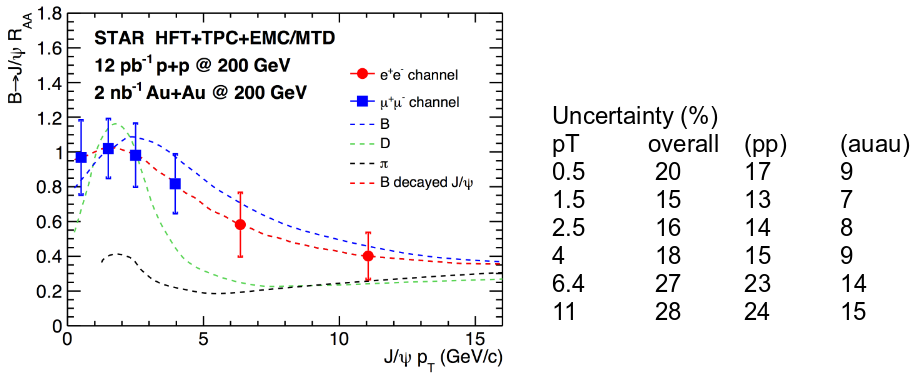

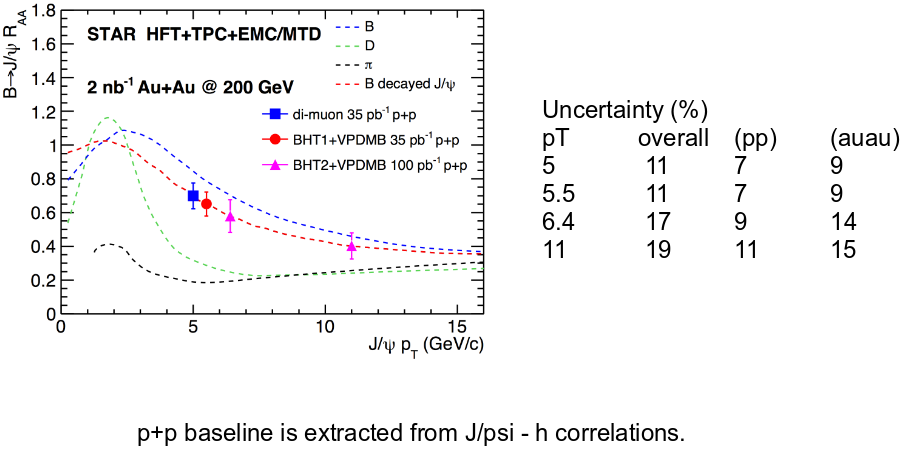
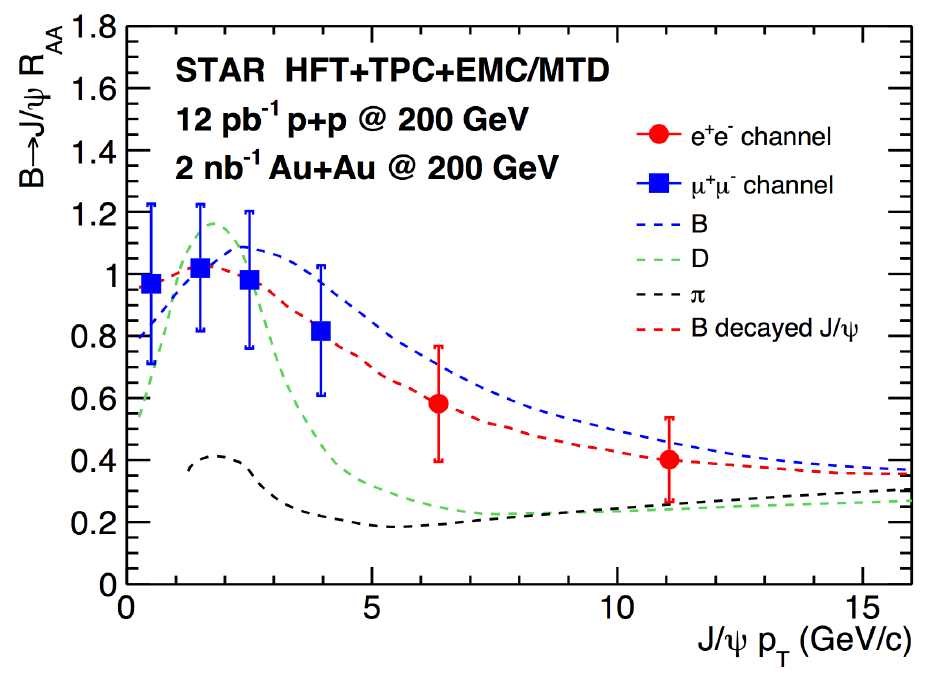
Projectios for B->J/psi RCP:
R_CP (0-10%/ 40-60%)

R_CP (0-10%/ 60-80%)

BUR15 Executive Summary
The STAR Collaboration makes the following two-year beam-use proposal, in order to achieve its spin and relativistic heavy ion physics goals on a timescale consistent with intense international interest and competition in these areas, as well as to utilize RHIC beams effectively, taking full advantage of recent improvements in machine and detector capability.
|
Run
|
Energy
|
Duration
|
System
|
Goals
|
priority
|
Sequence
|
|
16
|
ÖsNN=200 GeV
ÖsNN=62 GeV
ÖsNN=19.6 GeV
|
13-wk
4-wk
1-wk
|
Au+Au
Au+Au
d+Au
|
Lc, D v2, RAA, ϒ RAA
10nb-1, 2billion MB
1.2B MB, HT
100M MB
|
1
4
4
|
1
2
3
|
|
17
|
Ös = 510 GeV
ÖsNN=19.6 GeV
ÖsNN =200 GeV
ÖsNN=200 GeV
|
11 wk
1-wk
3-wk
3-wk
|
Transverse
p+p p+p
Ru+Ru
Zr+Zr
|
AN of W±, g, Drell-Yan,
L=400 pb-1, 55% pol 400M MB
1.2billion MB
1.2billion MB
|
2
4
3
3
|
1
2
3
4
|
Table 1 1: Scenario I-A: 22 cryoweeks for Run 17 with Isobar sources (Zr, Ru)
STAR’s top priority is to capitalize on the successful installation and operation of the Heavy Flavor Tracker (HFT) and Muon Telescope Detector (MTD) in runs 14 and 15. We request 13 weeks of Au+Au collsions at √s = 200 GeV to collect rare triggers for Upsilon states, gamma-jet correlations, B-->J/Psi and J/Psi production, as well as 2 billion minbias events for Lambda_c and differential studies of charm flow and correlations. The combination of the run 14 and run 16 will allow for measurements of each of the three Upsilon states. The heavy flavor and quarkonium program must be completed to fulfill STAR’s scientific program with the newly HFT and MTD upgrades before BES-II.
STAR’s second priority is to make the first significant measurement of the Sivers sign change and non-perturbative evolution effects in transverse momentum distributions via reconstruction of W+-, Z, direct photon and Drell-Yan single spin asymmetries in transversely polarized √s = 500 GeV p+p collisions. The sign change measurement is a fundamental test of QCD and is being pursued by other experiments, making a timely measurement imperative.
STAR’s third priority is to clarify the interpretation of the observed signatures of the chiral magnetic, wave and vortical effect by making measurements that disentangle signal from background v2 effects. We request a 3 week run each for Ruthinuium (Ru+Ru) and Zirconium (Zr+Zr) collisions. This choice of nuclei is ideal as it allows for a variation in magnetic field at a maximum of 10%, while keeping nearly all other parameters the same. This decisive measurement of the ratio of charge separation in the isobar while reducing the flow background to minimum will greatly advance our understanding of the chiral magnetic effect and has fundamental impact beyond the field of high-temperature QCD.
|
Run
|
Energy
|
Duration
|
System
|
Goals
|
priority
|
Sequence
|
|
16
|
ÖsNN=200 GeV
ÖsNN=62 GeV
|
13-wk
5-wk
|
Au+Au
Au+Au
|
Lc, D v2, RAA, ϒ RAA
10nb-1, 2billion MB
1.2B MB, HT
|
1
4
|
1
2
|
|
17
|
ÖsNN=510 GeV
ÖsNN = 14.5
ÖsNN = 19.6
ÖsNN = 39.0
Ös= 19.6
|
12-wk
1-wk
1-wk
1-wk
1-wk
|
Transverse
p+p
d+Au
d+Au
d+Au
p+p
|
AN of W±, g, Drell-Yan,
L=400 pb-1, 55% pol 80M MB
100M MB
400M MB
400M MB
|
1
4
4
4
4
|
1
5
4
3
2
|
Table 1 2: Scenario I-B: 22 cryoweeks for Run 17 for the case where the Ru-96 source cannot be procured.
Our next priority is to take data at lower beam energies. There are two programs in our requests in this category:
a) Au+Au collisions at 62 GeV for measurements of inclusive jets and charm spectrum at low energy.
With newly developed analysis techniques, an inclusive jet measurement is possible with minimum-bias data in Au+Au collisions. We have recently extended the measurement to Au+Au at 62GeV with limited statistics from run 10. We request 4 (5) weeks of Au+Au collisions at this energy for an inclusive jet RCP measurement. This will also provide a measurement of D0 spectrum from HFT.
b) d+Au and p+p collisions at low energies for study of onset of high-pt hadron nuclear modification due to jet quenching.
STAR has produced a systematic measurement of RCP of inclusive hadrons as a function of momentum from all the beam energies taken at RHIC. The data has shown a systematic increase of RCP from less than unity to significantly above unity when the beam energy varies from top energy of 200 GeV to 7.7 GeV. A combination of d+Au collisions and p+p collisions at energies where RCP is around unity will help us address the onset of final-state hadron suppression.
|
Run
|
Energy
|
Duration
|
System
|
Goals
|
priority
|
Sequence
|
|
16
|
ÖsNN=200 GeV
ÖsNN=62 GeV
ÖsNN=19.6 GeV
|
13-wk
4-wk
1-wk
|
Au+Au
Au+Au
d+Au
|
Lc, D v2, RAA, ϒ RAA
10nb-1, 2billion MB
1.2B MB, HT
100M MB
|
1
4
4
|
1
2
3
|
|
17
|
Ös=510 GeV
ÖsNN=19.6 GeV
|
11-wk
1-wk
|
Transverse
p+p p+p
|
AN of W±, g, Drell-Yan,
L=400 pb-1, 55% pol 400M MB
|
2
4
|
2
1
|
Table 1 3: Scenario II: 15 cryoweeks for Run 17 (assume Isobar sources not possible in run16)
In this beam use request the STAR Collaboration presents five compelling scientific programs for the upcoming RHIC runs 16 and 17. We discuss the highlights from the scientific publications, on-going analyses and detector performance from recent runs. We have also outlined the planned upgrades in the next few years in preparation for the Beam Energy Scan II.
Chiral Magnetic Effect theory and data projections
Hi, Zhangbu and all
I've received the magnetic field calculation results for isobar collisions from the theorists, http://www.star.bnl.gov/protected/bulkcorr/rexwg/flow/Parity/CuAu/By_cent.pdf
and I made a projection of our measurements.
http://www.star.bnl.gov/protected/bulkcorr/rexwg/flow/Parity/CuAu/PlotIsobar.gif
If we have 250M minbias events in each case, there will be a sweet zone of 20-50% centrality,
where the difference between Ru+Ru and Zr+Zr is a 3 sigma effect (combining centralities).
Gang Wang
Department of Physics & Astronomy UCLA
BUR writeup:
summary of the experimental study on chiral magnetic effect
Highlights and Accomplishments since last BUR
BES (14.5GeV)
-----Original Message-----
From: Nu Xu [mailto:nxu@lbl.gov]
Sent: Friday, April 17, 2015 5:26 AM
To: Xu, Zhangbu
Cc: Xu Nu; Alexander Schmah; Cebra Dan; Kikola Daniel; Aschenauer, Elke; Sichtermann Ernst P; Videbaek, Flemming; Geurts Frank; Fuqiang Wang; Wang Gang; Caines Helen; Drachenberg Jim; Ruan, Lijuan; Fatemi Renee; Dong Xin
Subject: Re: BUR16 committee meeting Firday 2-3PM
Hi Zhangbu and All,
Below is the list of analysis topics (and presentations) from14.5GeV Au+Au collisions. I have divided those topics into four groups, according to their phsics relevance. Roughly, about 50% of these topics are close to the end the analysis phase, however, almost all of them are awating for the results of the 14.5 GeV embedding.
As many of you know that we will have our first discussion (via BlueJeans) on the 14.5GeV data analysis status next Monday, April 20th. After the meeting, we plan to prepare for a summary including the “status/problem/plan for presentation and paper” for all topics.
Status of the14.5GeV data analysis
I. v1, v2, …vn:
(1) Paul S - Charged particle v_n
https://drupal.star.bnl.gov/STAR/system/files/sorensen_14.5GeV_update.pdf
(2) Yadav - v1 for p, pbar, pi+/-, K+/- http://www.star.bnl.gov/protected/bulkcorr/ypandit/KaonPaper/BulkCorr/Kaonv1Paper_Update.pdf
(3) Shusu - identified particle v2:
http://www.star.bnl.gov/protected/bulkcorr/sss/14.5_flow/14.5_v2_BES_dis.pdf
II. Spectra and RCP:
(1) Yu Ning and Rihan – Light nuclei production http://www.star.bnl.gov/protected/lfspectra/yuning/BES/pwg/B2-15-20150420.pdf
(2) Stephen Horvat and Daniel Brandenburg - R_cp http://www.star.bnl.gov/protected/lfspectra/jdb/run14/AuAu15/pidRcp/pidRcp_Update_April_10_lfs.pdf
(3) Spectra of pion, Kaon, Proton, K0, L, Xi, Omega from 14.5 GeV Au+Au collisions ??? (no responses yet from co-conveners)
III. High moments:
(1) Xiaofeng Luo and Jochen Thaeder - net-charge/net-proton moments http://www.star.bnl.gov/protected/bulkcorr/luoxf/PWG_discussion/Moments_14.5GeV_20150408.pdf
(2) Ji Xu - High moments net kaons
http://www.star.bnl.gov/protected/bulkcorr/xuj/bulk/JiXu_netK_moments_Version2.pdf
IV: Chiral effects:
(1) Gang Wang - CME/CMW:
http://www.star.bnl.gov/protected/bulkcorr/rexwg/flow/Parity/BES/14.5GeV_04082015.pdf
Best regards,
Nu Xu
Progress on production with the Muon Telescope
http://www.star.bnl.gov/protected/lfspectra/ruanlj/MTD/STAR_BUR1617_MTD_ProductionStatusRun1415.pdf
Low Energy Reference datasets
Au+Au62 ( I think PHENIX is proposing He3+Au for run16 at various energies)
Daniel, Alex and Helen on jets and HF
Do we need pp reference or all out for Au+Au
p+A
Helen, Cebra and Alex on R_PA, flow (lower energies)?
Elke on Spin
dielectron:
https://drupal.star.bnl.gov/STAR/blog/yiguo/error-projection-196-dau-die-spectra
NPE in Au+Au 62.4 GeV - current results and prospects for run 16
NPE spectra and v2 results from Au+Au 62.4 GeV run 2010
Slides 18 - 21 in Recent Open Heavy Flavor Results from STAR (RHIC & AGS Annual Users' Meeting 2014)
Prospects for NPE meausrements in Au+Au 62.4 GeV in run 16
(based on inputs from Mustafa Mustafa and James Dunlop)
Attached are ratio plots from theory calculations. The total charm cross-section is down by a factor of 4-5. However the pT dependence is not trivial.
The pT of charm quarks is, consequentially, harder at 200 GeV. For R_cp measurement it means a factor of 15-20 drop in cross-section in the interesting pT region (4-10 GeV/c).
For NPE v2 the harder spectra at 200 GeV implies that the NPE cross-section is down by a factor of 10 at low electron pT due to the feed down from higher pT.
Regarding the background, the NPE background is down by only a factor of 2 (with some pT dependence) from 200 to 62GeV.
Taking the projections for top energy of min/max = 2.2 nb^-1/ 3.6 nb^-1 /week (take the middle, say 3 nb^-1) at 200 GeV, then scaling down by E^2, would expect
~1.5 nb^-1 in such a run, delivered. Take 70% live, ~1 nb^-1.
So a factor of 5 or so possible vs. what was triggered in Run 10, also perhaps somewhat better with a narrower vertex distribution.
Not clear whether that pushes us over the top to make the HT trigger useful. It is unlikely, especially with the worse NPE S:B with the HFT.
Raw inclusive electron spectrum from Run 10 data:
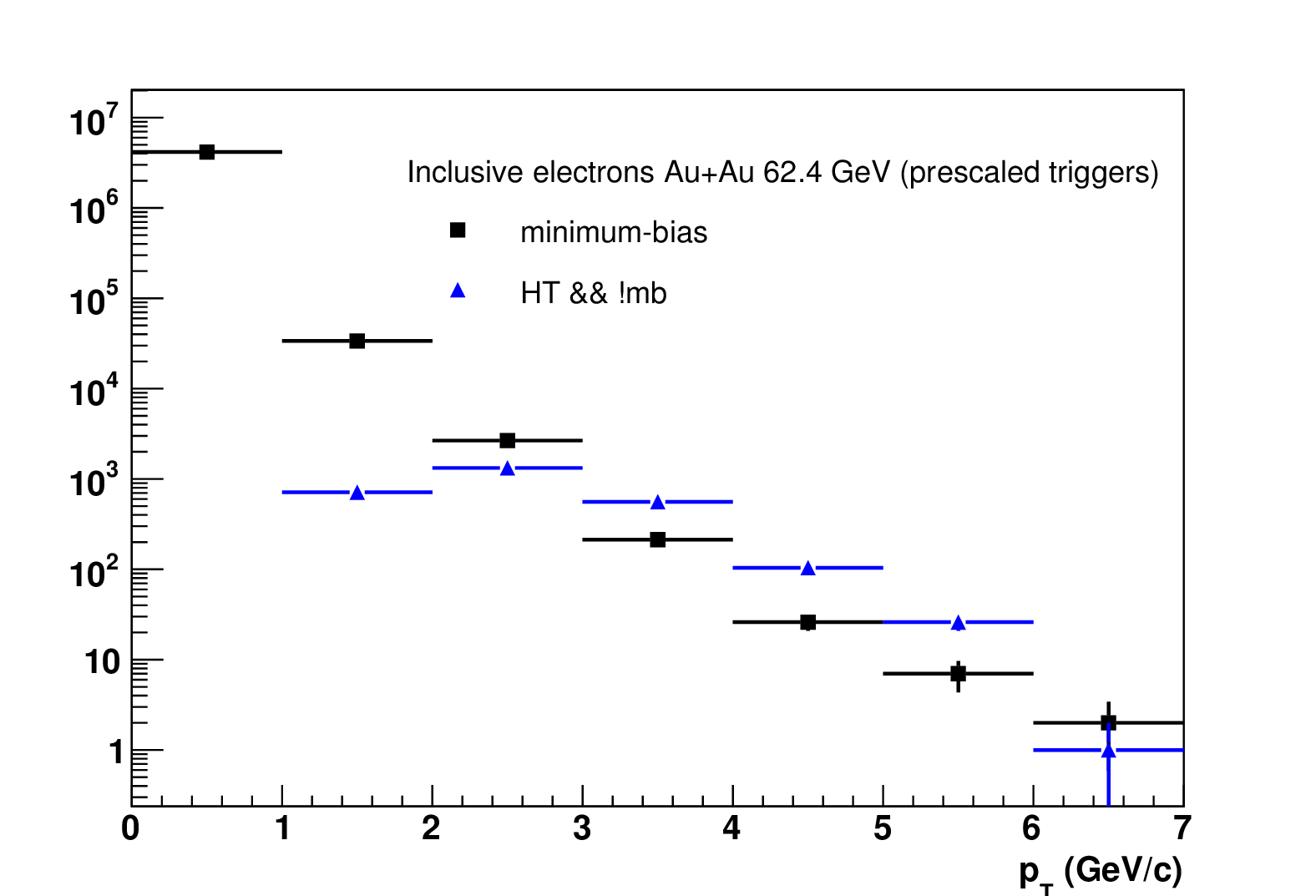 |
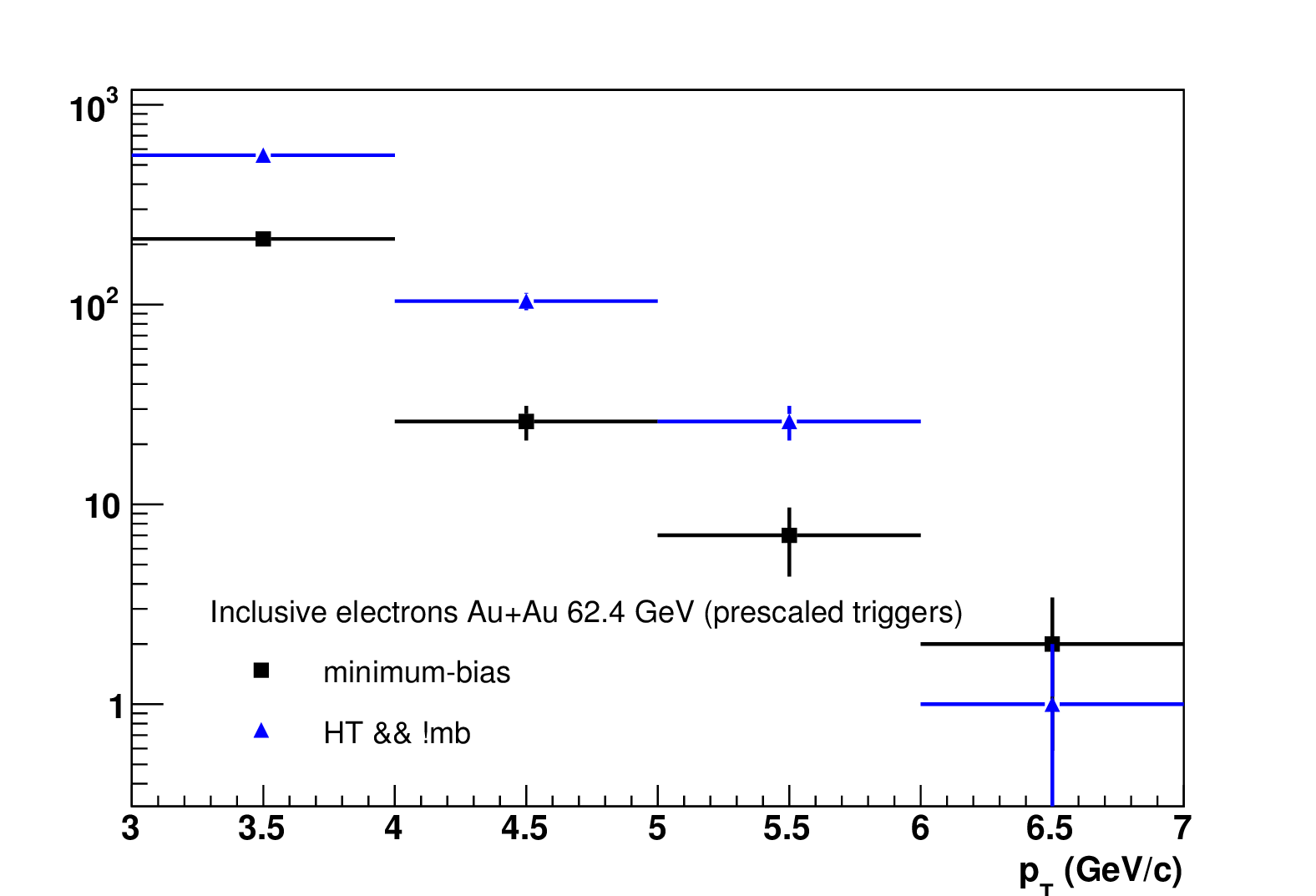 |
Charm cross section in p+p 200 GeV vs p+p 62.4 GeV
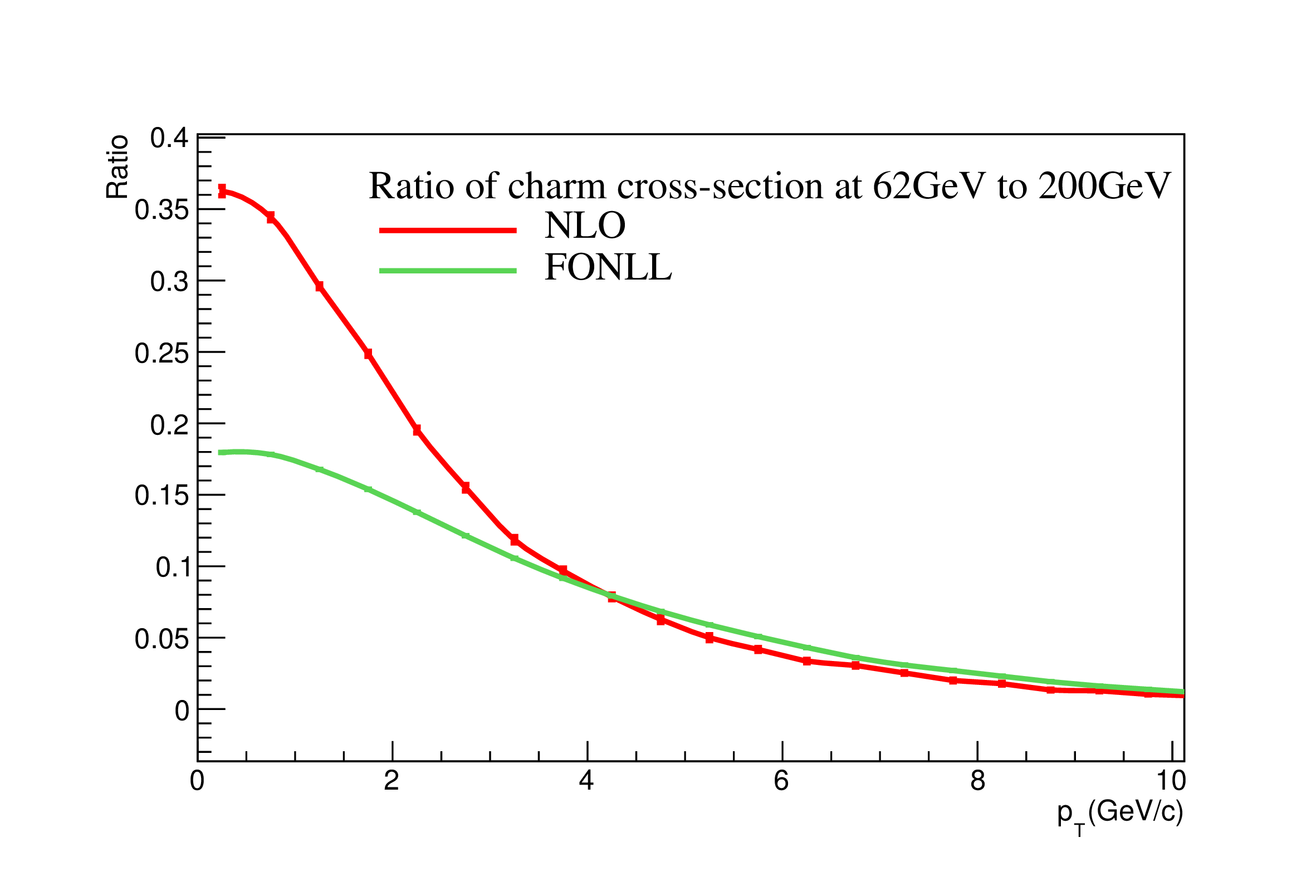

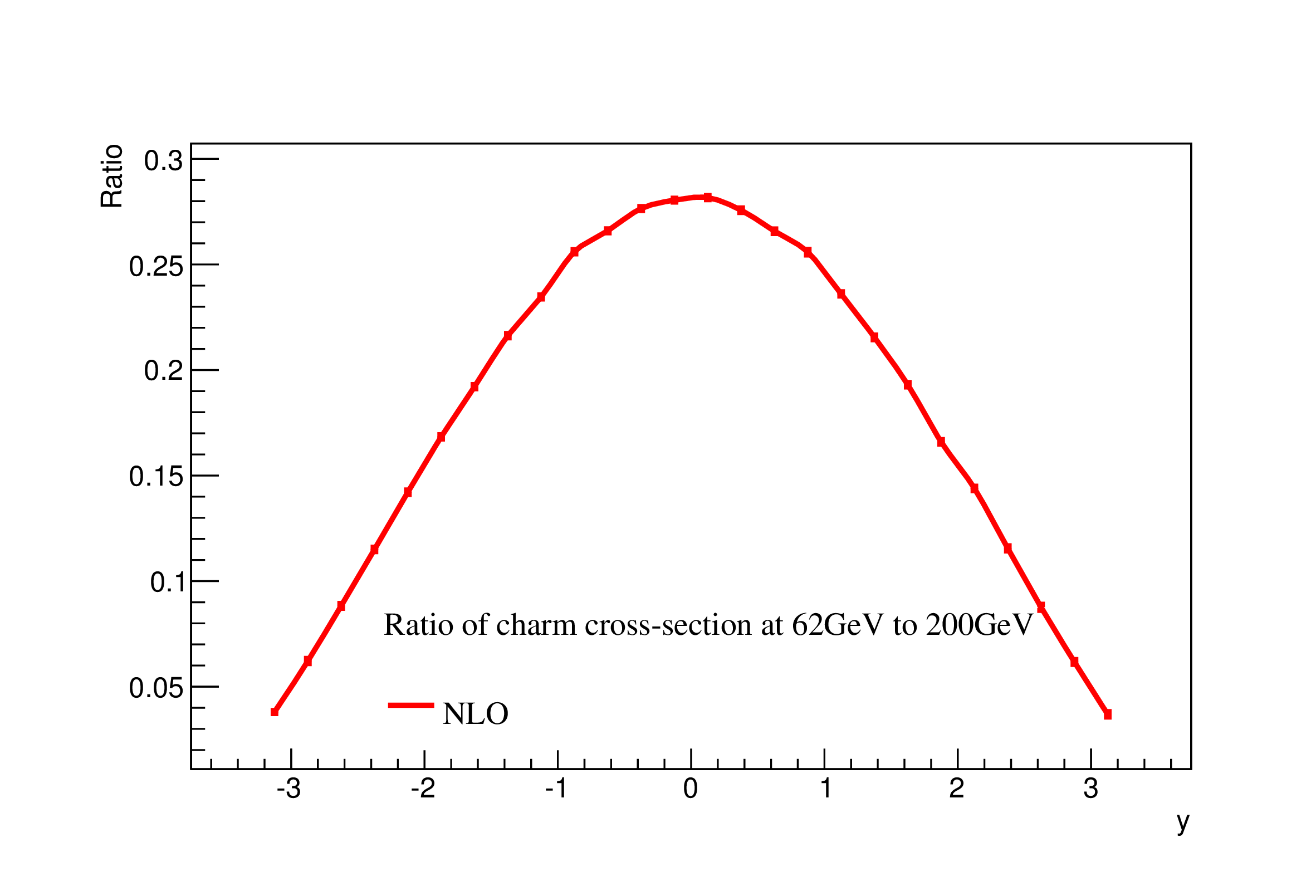
Run16 and AuAu62 GeV estimate
I had one presentation in the last Nov collaboration meeting talking about the Run16 and some quick estimate on the D0 v2 from 5 weeks of AuAu62 GeV
comments and feedbacks
-----Original Message-----
From: Sorensen, Paul
Sent: Friday, May 15, 2015 1:31 AM
To: Xu, Zhangbu
Subject: Re: [Starpapers-l] STAR Beam Use Request for run 16 and 17 (ready for collaboration feedback)
I believe there is an error in table 5-2. Isn’t CME supposed to be larger > in Ru+Ru and Zr+Zr? It’s listed as smaller < now.
-----Original Message-----
From: Carl Gagliardi [mailto:c-gagliardi@tamu.edu]
Sent: Thursday, May 14, 2015 4:05 PM
To: Xu, Zhangbu
Cc: rfatemi@pa.uky.edu; Aschenauer, Elke; 'Carl Gagliardi'
Subject: RE: [Starpapers-l] STAR Beam Use Request for run 16 and 17 (ready for collaboration feedback)
Hi Zhangbu (cc Renee and Elke):
I've made it through Sections 1-3 of the Version 12 draft BUR. I systematically tried to ignore minor typos, etc., that the PAC members should be able to read over easily. With that "constraint", I only have a few comments or suggestions so far:
-- General remark: The "Highlights" section is written in a very brief style. That's a good thing! But it means the knowledge that the PAC members bring to the document will be critical for them to understand everything that's discussed. (I admit that I had difficulty following some of the heavy ion highlights.) During your PAC talk, I could imagine that you might get one or two "what's this mean?" questions from members who had their interest tweaked by some figure. Be prepared.
-- Pg 13, Fig 2-9 caption: j_T is ~ Delta R * z * pT_jet. (The "* z" is
missing.)
-- Pg 16, 2nd last line: "... into a new ERA of lower x ..." (Admittedly, this is just a typo. But I simply couldn't read past it!)
-- Pg 33: The upper paragraph says Fig 3-2 is from p-Au running. The figure caption says it's from p+p. I suspect the figure caption is correct.
-- Pg 36: At present, there is nothing in Sect 3.2 "Dataset for inclusive jet and dijet A_LL". I'm probably the internal expert here. Should I prepare a brief paragraph and update our standard Runs 9+15 projection plot for insertion here?
I'll drop you another note after I've made it through the Runs 16&17 requests sections. I might (or might not) also have some retrospective suggestions for the Executive Summary at that time.
Carl
pp,pA BUR
request and projections for pp,pA